Plant This: Indian mallow
In my sunniest, driest garden beds, gray globemallow (Sphaeralcea incana) is a true performer. When I first spotted this Indian mallow in the exhibition hall at GWA Tucson last fall, I mistook it for another of the many species of Sphaeralcea. Was I surprised to learn that it’s an abutilon! Abutilon palmeri, in fact — a southwestern U.S. native and quite different from its shade-loving, thirstier cousins known as flowering maple or Chinese lantern.
Also called superstition mallow (for the Superstition Mountains in Arizona, part of its native range), Indian mallow needs very well-drained soil and plenty of sun. I brought this plant home in my suitcase from Tucson, not knowing if it would survive the winter in Austin since it’s rated hardy only to zone 9 (20 to 25 degrees F). Last winter turned out to be mild, and the plant remained evergreen.
In the spring it put out lots of new growth, and cup-shaped, orange flowers appeared soon after, continuing through the summer despite its neglect in a poorly watered, blasting-hot corner of the garden.
The silvery, heart-shaped leaves are large for a drought-tolerant plant — some are 5 to 6 inches across — but are soft and fuzzy to the touch, a water-conserving adaptation. Each one is as pettable as a stuffed bunny.
Since bringing it home, I’ve spotted Indian mallow in one other local garden. I don’t think it’ll be easy to find in Austin nurseries, and since it’s only marginally hardy a hard winter freeze may take it out. But if you like to live dangerously and have a protected but hot, dry, sunny spot, give Indian mallow a try. You’ll love it all summer and — fingers crossed! — all winter too.
I’m joining other bloggers for the Bloom Day meme with this post. Visit May Dreams Gardens to see what’s blooming in other gardens around the world on this date. And don’t forget to join me tomorrow for Foliage Follow-Up!
All material © 2006-2013 by Pam Penick for Digging. Unauthorized reproduction prohibited.


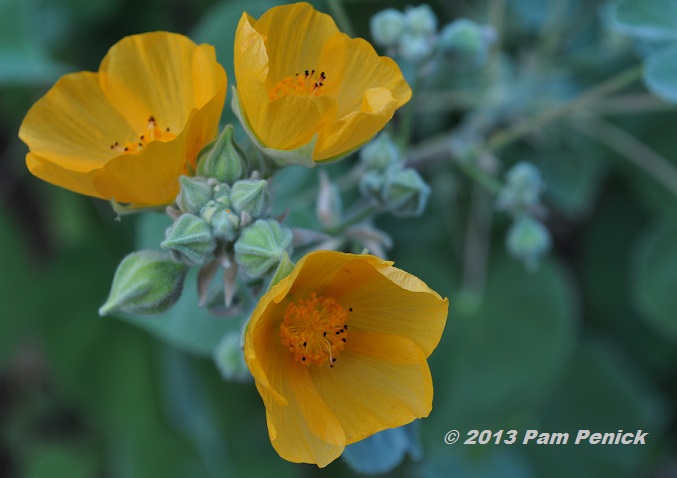
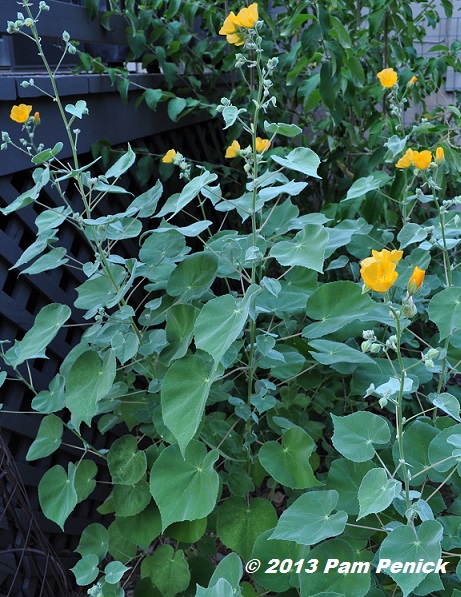
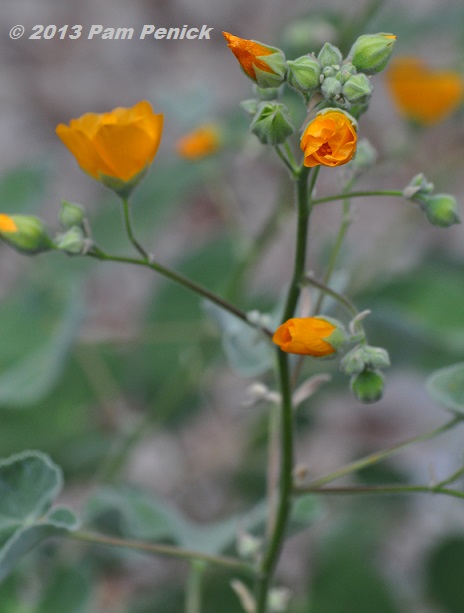
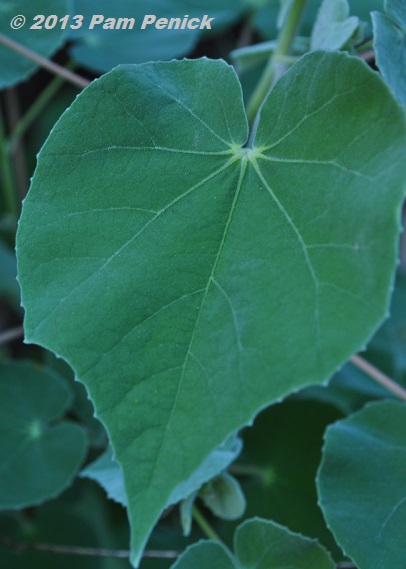
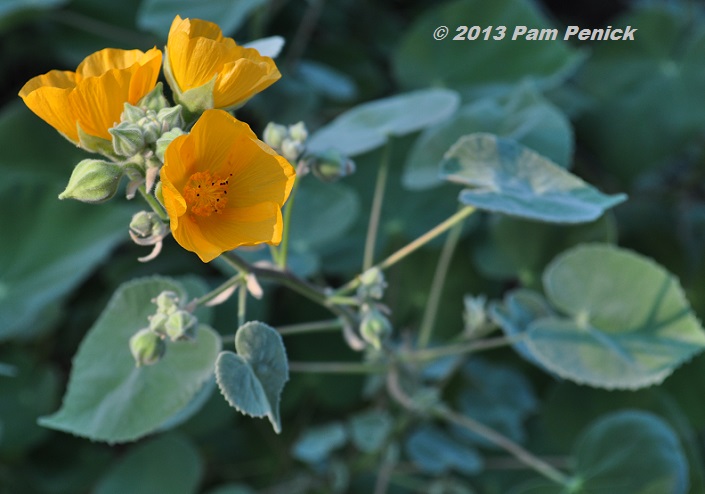
It is beautiful!
Happy Garden Bloggers’ Bloom Day!
Lea
Lea’s Menagerie
And to you, Lea. —Pam
Love this Mallow. Beautiful… Not one that I know at all.
Thanks for popping by, Mermaid. I would have left a comment on your lovely dahlia post, but I couldn’t without a Google acct. Lovely photos! —Pam
Love this one! Barton Springs nursery was carrying a few last fall, and it’s been thriving and blooming in my backyard ever since. It’s gotten 5ft tall having to compete for light with the trumpet vine but doesn’t seem to be bothered. And those leaves…so cuddly.
Mine’s at least that tall as well, Amy, with no competition for light. It’s a biggie! —Pam
You’re right in that it is not instantly recognizable to the Abutilons I see growing up here. A wonderful looking plant — and with great foliage!
Yes, the foliage is just as pretty as the flowers. Together they’re quite a nice combo. —Pam
So glad you wrote about this. Recent trip to Hill Country Gardens in New Braunfels is where I found one. Now that I have taken it to Fort Worth I will keep it in a pot for the winter.
Good plan, TufaGirl. And thanks for the heads-up on where you found one. —Pam
I adore this. Just added to my must-have list. Wonder where I could get a cutting? 😉
Just let me know when, Caroline. 🙂 —Pam
There’s an enormous specimen in a front garden down the street. It’s a beautiful plant when small — you may have the best of both worlds by having to renew it every so often!
Sounds like something a little hard pruning would fix, eh? —Pam
Very nice! Plants that are evergreen perennials in zone 9 usually behave as herbaceous perennials in zone 8 if they have fast drainage. I’ll be interested to see if you have that same result with this one after a normal winter.
I hope that will be the case, Peter. I’m sure we’re due for another hard winter (by Austin standards, anyway) after last year’s mild one. —Pam
Nice plant and lusher than globemallow to me. I never paid attention to this on my AZ trips. I also wonder if it might behave as a perennial in Z 8b…or if it might grow well, and reseed to come up.
Good question, David. I thought you might be familiar with this one. It would grow well for you in El Paso, I bet. —Pam
Is it deer resistant? (I have a Hill Country garden.)
I expect so, Ann. The leaves are very fuzzy, and that’s usually a deer turnoff. But mine’s in the fenced back yard, so I don’t know for sure. —Pam
I hear it’s not the heat it’s the humidity here…..Happy gbbd
I find it’s both — ha! Looking forward to fall… —Pam
I have a pale pink globe mallow that is thriving in full sun with little water. So far no problems with the deer in my Hill Country location but if they are hungry enough I suspect they may give it a try. I will search for this one. I love the color!
I don’t have the pink but do have the red and the orange globe mallows. Remember, this is actually an abutilon, although it resembles globe mallow. Another commenter (above) said she found one at Hill Country Gardens in New Braunfels. —Pam
There are so many globe mallows out there I find them very confusing to identify. This one certainly is a show stopper. My mallows have not done well this year. Some of them died back. I think they had become too big last year. Probably best to redo them every year.
I wonder if it will grow from seed. If so I am willing to give it a go although my mallows never made seed last year so I am thinking they must be hybrids.
Just to remind you, this plant is not a mallow but an abutilon, so it may behave differently. My green-leaved, red globe mallows didn’t perform very well this year either, but the silver-leaved, orange ones did great. —Pam
I was impressed by the plant when I saw the flower but even more so when I saw the leaves. Choice!
Isn’t it? 🙂 —Pam
Pam — I have a plant I bought at a SA Botanical Garden plant sale a few years ago that looks quite like this except with a more orange flower. I believe it was labeled something like velvetleaf mallow. Having perused the internet trying to figure out its “real name”, I’m still perplexed. Any idea if it’s this one?
I don’t know, Katie. Is there anyone you could contact at SABG? Maybe author Mary Irish? —Pam
I just got an abuliton, here we call it chinese lantern, and it doesnt look drought hardy to me! It wilts when it doesnt get its daily drink, but maybe once it settles in it wont be quite so sensitive.
I have several species of Chinese lantern as well, and no, that Abutilon is not particularly drought tolerant. This one, however, comes from the southwest deserts of the U.S., and it thrives in heat and dry conditions. That’s why I was so surprised to learn it was an abutilon. —Pam
Really enjoyed the mallow, the crinum and the oxblood lily this week. I too have a similar new mallow to go along with my lemon rose mallow which is putting on a big show now. The glowing albeit short-lived oxblood bloom is such a beautiful harbinger of fall that I buy a few bulbs each year to tuck into any newly available little spots that get some cool weather sun. I’d love to add the crinum if I can just control the Lotus that we let take over the pond in all its glory every summer. We attended a very fine Viva Tequila! presentation by Lucinda Hutson this week on all things agave including plant samples (mescal and tequila) and the Daylily club does its big lily auction next meeting, so ATX fall gardening is in full swing!!
I should post about my lemon rosemallow too, which was, coincidentally, a gift from the wonderful Lucinda Hutson. It’s a solid performer in my garden. Good luck controlling that lotus! —Pam
Pam, that Indian mallow is gorgeous–I love its silvery, heart-shaped leaves. I also adore the history behind it. Very cool! Thanks for sharing!
My pleasure, Julie. It would have been a good plant to showcase on Valentine’s Day with those leaves, wouldn’t it? —Pam
It’s a good plant. Wonderful. Happy Bloom Day Pam.
And to you, Dee! —Pam
Thanks for your post. I was looking up types of mallow since I found several plants in my back yard and your post popped up. It looks like they are Indian Mallow. I wonder how they got there, if they aren’t native? They have never been watered and have been completely ignored and are doing great. It seems they either survive our winter or reseed. They are in a pretty shaded spot up on a hill.
Well, aren’t you lucky to have gotten a freebie! Probably someone in a neighboring yard has one, and a seed made its way into your garden. —Pam
I’m an Arizona resident and LOVE this plant. If you’re interested in propagating it, leave the fruits on the stalks. They will dry into tan rondelles which are full of seeds. These plants grow BEAUTIFULLY from seed. They sprout fast in pod systems and grow quickly once planted in little pots. You should try propagating them if you really love this plant.